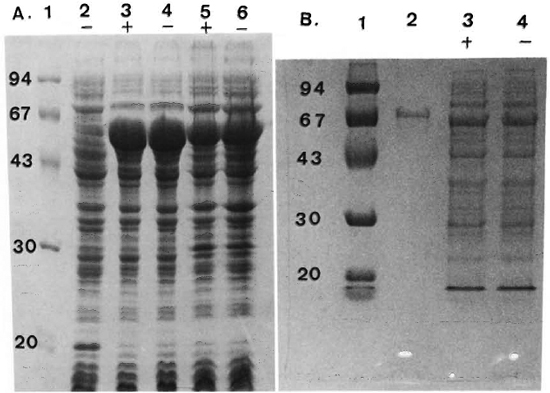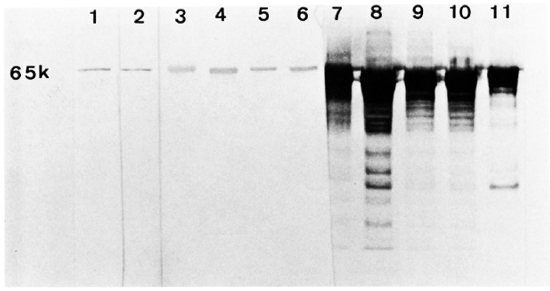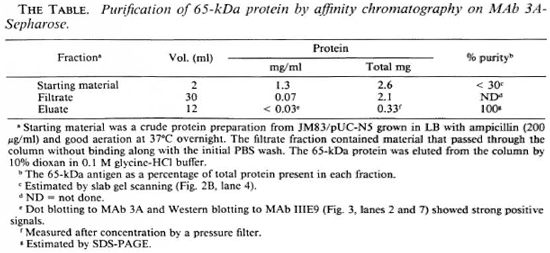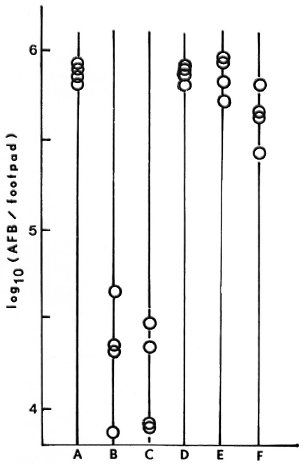- Volume 57 , Number 4
- Page: 817–24
Overproduction, affinity purification and characterization of 65-kDa protein of Mycobacterium leprae in Escherichia coli
ABSTRACT
The 65-kDa protein of Mycobacterium leprae was produced in an Escherichia coli strain carrying a plasmid harboring the re-cloned gene coding for the protein. The protein was purified through affinity chromatography prepared with the IgG fraction of a monoclonal antibody which was prepared against the 65-kDa protein. The purified 65-kDa protein also reacted immunologically with the monoclonal antibody IIIE9, which recognizes the epitope for M. leprae, prepared by Buchanan, et al. BALB/c mice were inoculated with M. leprae and 4 months later were skin tested with the purified 65-kDa protein. Gross changes were observed at the skin-test site. The role of the protein in protective immunity against M. leprae foot pad infection in mice was also studied.RÉSUMÉ
On a produit la protéine 65-kDa de Mycobacterium leprae dans une souche d'Escherichia coli incorporant le gène recloné qui code pour cette protéine. La protéine a été purifiée par chromatographic en faisant intervenir la fraction IgG d'un anticorps monoclonal préparé contre la protéine 65-kDa. Cette protéine purifiée 65-kDa réagissait immunologiquement aussi avec l'anticorps monoclonal IIIE9, qui reconnaît l'épitope de M. leprae préparé par T. Buchanan et col. Des souris BALB/c ont été inoculées par M. leprae et quatre mois plus tard, on a procédé à des épreuves cutanées avec-la protéine purifiée 65-kDa. Des modifications évidentes ont été observées à l'endroit de l'épreuve cutanée. On a également étudié le rôle de cette protéine dans l'immunité protectrice contre M. leprae dans le coussinet plantaire de la souris.RESUMEN
Se produjo la proteína de 65-kDa del Mycobacterium leprae en una cepa de Escherichia coli portadora de un plásmido conteniendo al gene reclonado codificante de esa proteína. La proteína se purificó por cromatografía de afinidad preparada con la fracción IgG de un anticuerpo monoclonal contra la proteína de 65-kDa. La proteína 65-kDa purificada también reaccionó inmu-nológicamente con el anticuerpo monoclonal IIIE9 preparado por T. Buchanan, et al. el cual reconoce el epitope de M. leprae. Se inoculó un grupo de ratones BALB/c con M. leprae y 4 meses después, los ratones se inyectaron en la piel con la proteína 65-kDa purificada. Se observaron cambios aparentes en los sitios de inyección. También se estudió el papel de la proteina en la inmunidad protectora contra la infección inducida por M. leprae en la almohadilla plantar del ratón.The slow growth of the pathogen and the failure of Mycobacterium leprae to grow in vitro have made the purification of this my-cobacterium difficult. Molecular cloning and expression of mycobacterial DNA in a suitable host vector system could be another interesting approach to obtaining mycobacterial protein antigens. Genes for the major protein antigens of M. leprae, M. tuberculosis and M. bovis BCG as determined by monoclonal antibodies (MAbs) have been cloned in lambda bacteriophage (19,23,24), and the neucleotides of the genes encoding the 65-kDa protein have been sequenced (11,16,19).
The 65-kDa protein of M. leprae is present in a wide range of mycobacterial species (1), and the protein is a major immuno-reactive protein of mycobacteria. Antibodies directed against this protein can be detected in the sera of patients with leprosy and tuberculosis, and T cells reactive with this antigen can be isolated from patients with leprosy or tuberculosis as well as from BCG-vaccinated persons (3-5,12,18). The B-cell and T-cell epitopes on the immunodominant 65-kDa proteins of M. bovis BCG were determined by the use of recombinant antigens expressed in Escherichia coli (20). Recently, the 65-kDa protein has been determined to be a stress protein and has been described as an immune target in leprosy and tuberculosis (17,22).
The 65-kDa protein of M. leprae was purified from E. coli carrying the recombinant DNA as described by Lamb, et al. (7), and we also purified the protein from E. coli for further experiments. Here, we report on the purification of the overproduced protein in E. coli by affinity chromatography, the skin responses of BALB/c mice inoculated with M. leprae, and the role of the protein in protective immunity against M. leprae in mouse foot-pad infections.
MATERIALS AND METHODS
Bacteria, plasmid and phages. The E. coli strains used were JM83 (ara, dlac-pro, rpoL, thi, d80lacZdM15) (17), and Y1090 (dlacU169, proA+ , dlon, araD139, rpoL, supF, trpC22, Tn10, pMC9) for the titration of the λgt11 phage, and Y1089 lysogenized with the lambda phage Y4178 which contained a cloned DNA fragment for the 65-kDa protein of M. leprae (24). Strains Y1090 and Y4178 were generously provided by Dr. R. A. Young (Whitehead Institute, Cambridge, Massachusetts, U.S.A.). Plasmid pUC8 was used as the cloning vector (8).
DNA manipulation. Plasmid DNA and phage DNA were prepared as described by Davis, et al. (2). The methods for DNA manipulation were as described by Maniatis, et al. (9).
Detection of 65-kDa protein. Transformant cells (JM83) carrying the recombinant plasmids containing the DNA fragment for the entire 65-kDa protein of leprae were grown in Luria-Bertani (LB) broth containing ampicillin (200 μg/ml) and isopropyl-β-D-thiogalactopyranoside (IPTG; 3 mM) at 37șC, with aeration overnight, and harvested by centrifugation. The cells were suspended in 0.01 M phosphate-buffered saline (PBS), pH 7.2, at 1/10 of the original culture volume, treated with protease inhibitor (phenylmethyl sulfonyl fluoride; 1 mM), and ultrasonicated for 1 min at 35 W (Ohlake Works, Osaka, Japan). Antigen production was examined by dot blotting using a MAb IIIE9, which recognizes an epitope in the 65-kDa protein of M. leprae. The MAb IIIE9 ascites fluid was generated in Dr. Buchanan's laboratory (Seattle, Washington, U.S.A.) (4), and obtained through the Immunology of Leprosy (IMMLEP) Scientific Working Group of the World Health Organization (WHO).
Preparation of a monoclonal antibody. The cells producing a MAb 3A against the 65-kDa protein of M. leprae were prepared by immunization of BALB/c mice with M. leprae (details have been described elsewhere 10,13). The MAb 3A was found to crossreact with all bacilli tested (13).
Purification of the 65-kDa protein of M. leprae by immunoaffinity chromatography. Immunoaffinity chromatography was done by the method of Young, el at. (21). The globulin fraction precipitated by 50% (NH4)2SO4 from the ascitic fluid containing the MAb 3A was purified on an affinity column of staphylococcal protein A-Sepharose CL-4B (Pharmacia, Uppsala, Sweden). Column fractions containing the purified MAb 3A immunoglobulin G were pooled, di-alyzed against the coupling buffer (0.1 M NaHCO3, pH 8.3, containing 0.5 M NaCl), and concentrated by pressure filtration on a YM5 membrane (Amicon Corporation, Lexington, Massachusetts, U.S.A.) to a protein concentration of about 7 mg/ml. One ml of this material was reacted with 0:33 g of CNBr-activated Sepharose 4B (Pharmacia) as recommended by the manufacturer. The column (1 ml) was washed with PBS and stored at 4șC in PBS with 0.1% w/v sodium azide.
The supernatant of 100,000 x g x 60 min centrifugation of sonicated cell lysate of JM83 carrying pUC-N5, which contained the recloned DNA fragment, was applied on the MAb 3A IgG-Sepharose 4B column. The column was washed with PBS until the elutc had no detectable OD280. The bound material was then eluted with four column-volumes each of three elution buffers containing: a) 1.0 M NaCl, b) 0.1 M glvcine-HCl (pH 2.5), and c) 10% v/v diox-an in 0.1 M glycine-HCl (pH 2.5). The column was then re-equilibrated with PBS and stored with PBS containing 0.1% azide. Fractions (20 drops/tube) were neutralized and assayed for the 65-kDa protein by dot blotting with the MAb 3A. Fractions containing the protein were collected, dialyzed in PBS, and concentrated by pressure filtration (Amicon). Protein concentrations were measured with bovine serum albumin (BSA) as the standard using BCA Protein Assay Reagent (Pierce Chemical Co., Rockford, Illinois, U.S.A.).
Immunization and skin testing of mice. Female BALB/c mice (6-8 weeks old) bred at Clea Japan, Inc., were immunized intra-dermally (i.d.) in the chest with 107 to 108 intact M. leprae (Thai 53 strain) in 0.1 ml PBS. Four months after immunization, the immunized and control mice were challenged with an i.d. injection of 0.05 ml of sterile saline, 5 Mg of M. leprae lysate, or 5 μgof affinity-purified 65-kDa protein in the foot pad. M. leprae (Thai 53 strain) was maintained in nude mice. M. leprae lysate was prepared as previously described (10).
Increases in foot-pad size were measured by 24, 48, and 72 hr after antigen challenge by using a screw-gauge micrometer (Ozaki Mfg. Co., Japan). Sterile saline alone did not induce any foot-pad swelling over the period studied.
Assay of protective immunity. The mouse foot-pad model of Shepard (15) was used to test the role of the antigen in protective immunity against M. leprae infection. BALB/c mice (6-8 weeks old) were immunized (i.d.) in the chest with antigens. The antigens consisted of a suspension of M. bovis BCG, a mixture of BCG and M. leprae, E. coli carrying pUC8 or pUC-N5 without adjuvant, or affinity-purified 65-kDa protein with Freund's incomplete adjuvant. The dose per mouse was 107 M. bovis BCG, 107 M. leprae, approximately 109 E. coli carrying pUC8 or pUC-N5, and 17 μg of affinity-purified 65-kDa protein. The BCG was our usual culture that originated from the Tokyo strain. Three weeks after immunization, 5 x 103 M. leprae were inoculated into the right hind foot pad. Nine months later, the number of M. leprae in the right hind foot pad was counted by Shepard's method (14).
RESULTS
Subcloning of the gene encoding the 65-kDa protein of M. leprae
To construct a hyperproducing system of the 65-kDa protein of M. leprae, a 3.6-kb DNA fragment Hanked with EcoRI sites was isolated from a phage strain Y4178, a derivative of the λgt11 phage containing the chromosomal fragments of M. leprae constructed by Young, et al. (24), and recloned into the EcoRIsite on a plasmid vector, pUC8. The recombinant plasmids were introduced into strain JM83, and three transformant colonics were selected, pUC-N4, pUC-N5, and pUC-N7.
The orientation of the inserted DNA fragment was determined by comparing the length of the DNA fragment flanked with Smal, since the sites are included in the 3.6-kb DNA fragment (at nucleotide 30533058), and vector plasmid. In plasmid pUC-N5, the gene coding for the 65-kDa protein was inserted downstream of the lac promoter on the vector contained in the same orientation; in plasmids pUC-N4 and pUC-N7, the gene for the 65-kDa protein was in the opposite orientation (Fig. 1).

Fig. 1. Subcloning of DNA for the 65-kDa protein of M. leprae. DNA for M. leprae ( ) was inserted into the EcoRIsite of vector pUC8 to produce plasmids pUC-N5 and pUC-N8, which contain the insert in opposite orientations.
) was inserted into the EcoRIsite of vector pUC8 to produce plasmids pUC-N5 and pUC-N8, which contain the insert in opposite orientations.
Production of 65-kDa protein of M. leprae in E. coli
Plasmids pUC-N4, pUC-N5, and pUC-N7 were introduced into strain JM83 by transformation, and the production of the M. leprae protein was examined by dot blotting using MAb IIIE9. All of these transformant strains produced the protein under induced and noninduced conditions (data not shown). The amounts of the protein produced by JM83 cells carrying pUC-N5 or pUC-N7 were 25% to 45% of the crude extracts estimated by SDA-polyacrylamide gel (12.5%) electrophoresis followed by spectrophotometric scanning of Coomassie brilliant blue-stained gel (Fig. 2). The fact that the 65-kDa protein is also overproduced in the cells carrying pUC-N7, in which the gene for the 65-kDa protein was in an opposite orientation on the vector, suggests that the 3.6-kb DNA fragment contains the promoter region of the gene and is expressed and, therefore, docs not require IPTG for induction in an E. coli cell.

Fig. 2. SDS-PAGE gel with 5 μl of the protein preparation stained with Coomassie brilliant blue. A. Lane 1, molecular weight standard (103); lane 2, JM83/pUC8; lanes 3 and 4, JM83/pUC-N5; lanes 5 and 6, JM83/ pUC-N7. B. Lane 2, affinity-purified 65-kDa protein (< 0.03 mg/ml); lanes 3 and 4, JM83/pUC-N5 (+ and -indicate the presence or absence of IPTG, respectively).
The 65-kDa protein produced in coli cells was examined for its immunological reaction with MAb IIIE9 by Western blotting (Fig. 3, lanes 3-6). The proteins with a molecular mass of 65-kDa reacted with the MA.b IIIE9, and were produced in cells carrying the recombinant plasmids containing the DNA fragment inserted either in the same or in the opposite orientation of the lac promoter, with and without IPTG. Smaller reacting species (< 65 kDa) were also observed when large amounts of the extracts were used (Fig. 3, lanes 8-11) or when the protease inhibitor (PMSF) was omitted from the protein preparation.

Fig. 3. Western blotting with MAbs. For each lane, 0.5 μl (lanes 1-6) and 5 μl (lanes 7-11) of the protein preparation was elcctrophoresed on 12.5% SDS-PAGE and tranferrcd to nitrocellulose. Except for lane 1, the immobilized proteins were reacted with MAb IIIE9; lane 1 was reacted with MAb 3A. Loading material: Lane 1, JM83/pUC-N5; lanes 2 and 7, affinity-purified 65-kDa protein; lanes 3 and 8, JM83/pUC-N5 with IPTG; lanes 4 and 9, JM83/pUC-N5; lanes 5 and 10, JM83/pUC-N7 with IPTG; lanes 6 and 11, JM83/pUC-N7.
Purification of 65-kDa protein. A crude lysate of JM83 cells carrying pUC-N5 (Fig. 2B, lane 4) was purified through immu-noaffinity chromatography on MAb 3A IgG-Sepharose (The Table). A single protein band with a molecular mass of 65-kDa was detected by direct staining of the gel with Coomassie brilliant blue after immunoaffinity chromatography (Fig. 2B, lane 2). The purified protein reacted with the MAb IIIE9 by Western blotting (Fig. 3, lanes 2 and 7).

DTH response of BALB/c mice. Gross changes following the i.d. injection of the 65-kDa affinity-purified protein in M. leprae-immunized mice are shown in Figure 4. A response of 5 ”gof the 65-kDa protein is observed, but it is weaker than the response to 5 of the M. leprae lysate.

Fig. 4. Delayed-type hypersensitivity (DTH) responses of mice immunized with M. leprae. Responses of immunized mice to M. leprae lysate ( ) and the 65-kDa protein (
) and the 65-kDa protein ( ) are compared with those of control mice (
) are compared with those of control mice ( and
and  ). Results are the means from four mice; error bars show standard deviations.
). Results are the means from four mice; error bars show standard deviations.
Role of the 65-kDa protein in protective immunity. The design of the experiment is shown in Figure 5. The counts of M. leprae in the right hind foot pad were carried out on four mice from each group. The results show that live BCG or the mixture of live BCG and M. leprae gave significant protection; whereas the M. leprae 65-kDa protein or E. coli producing the 65-kDa protein were not effective with this method. High antibody levels against the 65-kDa protein of M. leprae were found in the sera of mice immunized with affinity-purified 65-kDa protein of M. leprae (data not shown).

Fig. 5. Results of harvests at 9 months after inoculation of 5 x103 M. leprae into the mouse foot pad. Mice were immunized intradermally with antigens 21 days before challenge. A = control mice; B = mice immunized with M. bovis BCG; C = mixture of BCG and M. leprae; D = E. coli carrying pUC-N5; E = coli carrying pUC8; F = affinity-purified 65-kDa protein. Each circle represents one mouse.
DISCUSSION
With the subclones that overproduced the 65-kDa protein of M. leprae, the amount of this protein needed for a detailed study could easily be affinity purified. The structural gene of the 65-kDa protein of M. leprae was found by Young and co-workers to be on a 3.6-kb EcoRI fragment of the recombinant phage Y4178 (24). The entire 3.6-kb fragment was recloned into the overexpression vector pUC-8 as described here and by Lamb, et al. (7). In both orientations of this fragment in the vector, the level of production of the 65-kDa protein was equally high under non-inducing conditions as described here. This result also confirmed the observations by Shinnick (16), Thole, et al. (18), and Lamb, et al. (7) that the expression of the 65-kDa protein was controlled by a mycobacterial promoter, although the transcriptional signals in M. leprae deviate from the consensus sequence in E. coli (16,18).
The positive skin-test responses elicited with the affinity-purified 65-kDa protein provide evidence that certain antigenic epitopes of this protein are capable of reacting with lymphocytes of M. leprae-infected mice that are involved in the DTH response. The 65-kDa protein used was purified with the MAb 3A which crossreacted with all bacilli tested, including the E. coli 65-kDa protein. For this reason some contamination of the affinity-purified M. leprae protein with E. coli 65-kDa protein could have occurred. In retrospect, it would have been better to have used a MAb to isolate the M. leprae protein which did not crossreact with E. coli. On the other hand, the 65-kDa protein of M. leprae bears epitopes also found on other bacilli (1,4,5,13,17). Because of this, it is limited in its applicability as a specific skin-test reagent for leprosy.
The 65-kDa protein is one of the determinants to induce DTH responses in mice infected with M. leprae (this study and 7). We tried to determine if the 65-kDa protein itself could induce the protective immunity against M. leprae growth in mice as described here. The relationship between DTH and protective immunity as induced by mycobacterial vaccines remains a crucial problem (6). In our experimental conditions, the protein itself did not induce protective immunity, although the immunized mice had high serum antibody levels against the 65-kDa protein of M. leprae. However, a more detailed analysis of the ability of the protein to elicit cellular immunity is needed to conclude that the 65-kDa protein is not capable of inducing protective immunity against leprosy.
Acknowledgments. We thank Dr. R. A. Young. Whitehead Institute, for kindly supplying the M. leprae gene library and the WHO IMMLEP monoclonal antibody bank for providing MAb IIIE9. We also thank Dr. M. Amemura, Research Institute for Microbial Diseases, Osaka University, for assistance in gene cloning.
Our research has been supported by a grant from the U.S.-Japan Cooperative Medical Science Program, funding from the Sasakavva Memorial Health Foundation, and a scholarship for Dr. Matsuoka from the Taniguchi Memorial Fellowship.
REFERENCES
1. Buchanan, T. M., Nomaguchi, H., Anderson, D. C, Young. R. A., Gillis, T. P., Britton, W. J., Ivanyi, J., Kolk, A. H. J., Closs, O., Bloom, B. R. and Mehra, V. Characterization of antibody-reactive epitopes on the 65-kilodalton protein of Mycobacterium leprae. Infec. Immun. 55(1987)1000-1003.
2. Davis, R. V., Botstein, D. and Roth, J. R. Advanced Bacterial Genetics; A Manual for Genetic Engineering. Cold Spring Harbor, New York: Cold Spring Harbor Laboratory, 1980.
3. Emmrich, F. J., Thole, J., van Embden, J. and Kaufmann, S. H. E. A recombinant 65 kilodalton protein of Mycobacterium bovis bacilli Calmette-Guerin specific ally stimulates human T4 clones reactive to mycobacterial antigens. J. Exp. Med. 163(1986)1024-1029.
4. Engers, H. D., Abe. M., Bloom, B. R., Mehra, V., Britton W., Buchanan, T. M., Khanolkar. S. K., . Young, D. B., Closs, O., Gillis, T., Harboe, M., Ivanyi. J., Kolk, A. H. and Shepard, C. C. Results of a World Health Organization-sponsored workshop on monoclonal antibodies to Mycobacterium leprae. Infect. Immun. 48(1985)603-605.
5. Engers, H. D., Houba, V., Bennedsen, J., Buchanan, T. M., Chaparas, S. D., Kadival, G., Closs, O., David, J. R., van Embden, J. D. A., Godal, T., Mustafa, S. A., Ivanyi, J., Young, D. B., Kaufmann, S. H. E., Khomenko, A. G., Kolk, A. H. J., Kubin, M., Louis. J. A., Minden, P., Shinnick. T. M., Trnka, L. and Young, R. A. Results of a Workd Health Organization-sponsored workshop to characterize antigens recognized by mycobactorium-spocific monoclonal antibodies. (Letter) Infect. Immun. 51(1986)718-720.
6. Fine, P. E. M., Ponnighaus, J. M. and Maine, H. P. The relationship between delayed type hypersensitivity and protective immunity induced by mycobacterial vaccines in man. Lepr. Rev. 57(1986)275-283.
7. Lamb, F. I., Kingston, A. E., Estrada-G., I. and Colston, M. J. Heterologous expression of the 65-kilodalton antigen of Mycobacterium leprae andmurine T-cell responses to the gene product. Infect. Immun. 56(1988)1237-1241.
8. Makino, K., Shinagawa. H. and Nakata, A. Cloning and characterization of the alkaline phosphatase positive regulatory gene (phoM) of Escherichia coli. MGG 195(1984)381-390.
9. Maniatis. T., Fritsch, E. F. and Sambrook, J. Molecular Cloning: A Laboratory Manual. Cold Spring Harbor, New York: Cold Spring Harbor Laboratory, 1982.
10. Matsuoka, M., Nomaguchi, H., Miyata. Y. and Ito, T. Production of monoclonal antibody to a 65,000 dalton protein of Mycobacterium leprae. Jpn. J. Lepr. 56(1987)21-25.
11. Mehra, V., Sweetser. D. and Young, R. A. Efficient mapping of protein antigenic determinants. Proc. Natl. Acad. Sci. U.S.A. 82(1986)7013-7017.
12. Mustafa. A. S., Oftung F., Gill, H. K. and Nat-vig, I. Characteristics ofhuman T-cell clones from BCG and killed Mycobacterium leprae-vaccinated subjects and tuberculosis patients. Lepr. Rev. 57(1986)123-137.
13. Nomaguchi. H., Matsuoka. M., Miyata, Y., Shigyo, Y., Kohsaka. K., Subowo, and Ito, T. Successful preparation and characterization of monoclonal antibodies to a 65.000 dalton protein of Mycobacterium leprae. Jpn. J. Lepr. 57 (1988) (in press).
14. Shepard, C. C. The experimental disease that follows the injection of human leprosy bacilli into foot-pads of mice. J. Exp. Med. 112(1960)445-454.
15. Shepard, C. C. Vaccination of mice against M. leprae infection. Int. J. Lepr. 44(1976)222-226.
16. Shinnick, T. M. The 65-kilodalton antigen of Mycobacterium tuberculosis. J. Bacteriol. 169(1987)1080-1088.
17. Shinnick, T. M., Vodkin, M. H. and Williams, J. C. The Mycobcterium tuberculosis 65-kilodalton antigen is a heat shock protein which corresponds to common antigen and to the Escherichia coli GroEL protein. Infect. Immun 56(1988)446-451.
18. Thole. J. E. R., Dauwerse, H. G., Das, P. K., Groothuis, D. G., Schouls, L. M. and van Emb-den, J. D. A. Cloning of Mycobacterium bovis BCG DNA and expression of antigens in Escherichia coli. Infect. Immun. 50(1985)800-806.
19. Thole, J. E. R., Keulen, W. J., Kolk, A. H. J., Groothuis, D. G., Berwald, L. G., Tiesjema, R. H. and van Embden, J. D. A. Characterization, sequence determination, and immunogenicity of a 64-kilodalton protein of Mycobacteria bovis BCG expressed in Escherichia coli K-12. Infect. Immun. 55(1987)1466-1475.
20. Thole, J. E. R., van Schooten, W. C. A., Keulen, W. J., Hermans, P. W. M., Janson, A. A. M., de Vries, R. R. P., Kolk, A. H. J. and van Embden, J. D. A. Use of recombinant antigens expressed in Escherichia coli K-12 to map B-cell and T-cell epitopes on the immunodominant 65-kilodalton protein of Mycobacterium bovis BCG. Infect. Immun. 56(1988)1633-1640.
21. Young, D., Kent, L., Rees, A., Lamb, J. and Ivanyi, J. Immunological activity of a 38-kilo-danlon protein purified from Mycobacterium tuberculosis. Infect. Immun. 54(1986)177-183.
22. Young, D., Lauthigra, R., Hendrix, R., Sweet-ser, D. and Young, R. A. Stress proteins are immune targets in leprosy and tuberculosis. Proc. Natl. Acad. Sei. U.S.A. 85(1988)4267-4270.
23. Young, R. A., Bloom, B. R., Grosskinsky, C. M., Ivanyi, J., Thomas, D. and Davis, R. W. Dissection of Mycobacterium tuberculosis antigens using recombinant DNA. Proc. Natl. Acad. Sci. U.S.A. 82(1985)2583-2587.
24. Young, R. A., Meura, V., Sweetser, D., Buchanan, T. M., Clark-Curtiss, J., Davis, R. V. and Bloom, B. R. Gene for the major protein antigens of the leprosy parasite Mycobacterium leprae. Nature (London) 316(1985)450-452.
1. Ph.D.; Research Institute for Microbial Diseases, Osaka University, 3-1 Yamadaoka, Suita, Osaka 565, Japan.
2. Ph.D.; Research Institute for Microbial Diseases, Osaka University, 3-1 Yamadaoka, Suita, Osaka 565, Japan.
3. Ph.D., Research Institute for Microbial Diseases, Osaka University, 3-1 Yamadaoka, Suita, Osaka 565, Japan.
4. M.D., Ph.D., Research Institute for Microbial Diseases, Osaka University, 3-1 Yamadaoka, Suita, Osaka 565, Japan.
5. Ph.D., National Institute for Leprosy Research, Higashimurayama City, Tokyo 189, Japan.
Received for publication on 10 January 1989.
Accepted for publication in revised form on 5 June 1989.